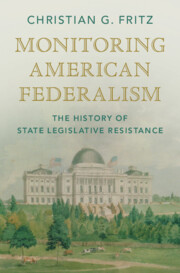Book contents
- Monitoring American Federalism
- Studies in Legal History
- Monitoring American Federalism
- Copyright page
- Dedication
- Contents
- Acknowledgments
- Introduction
- 1 The Riddle of Federalism and the Genesis of Interposition
- 2 Early State Use of Interposition: Testing the Powers of the New National Government
- 3 State Interposition and Debates over the Meaning of the Constitution
- 4 The Virginia and Kentucky Resolutions and Madison’s Report of 1800
- 5 State Interposition during the Jefferson and Madison Presidencies
- 6 State Challenges to the Supreme Court’s Control over Constitutional Interpretation
- 7 The Transformation of Interposition: The Theory of Nullification Emerges
- 8 State Interposition and Nullification on the Path to Secession
- 9 State Interposition during and after the Civil War
- 10 Modern Interposition by States and “Nullification”
- Abbreviations
- Notes
- Selected Short Titles
- Index
10 - Modern Interposition by States and “Nullification”
Published online by Cambridge University Press: 05 January 2023
- Monitoring American Federalism
- Studies in Legal History
- Monitoring American Federalism
- Copyright page
- Dedication
- Contents
- Acknowledgments
- Introduction
- 1 The Riddle of Federalism and the Genesis of Interposition
- 2 Early State Use of Interposition: Testing the Powers of the New National Government
- 3 State Interposition and Debates over the Meaning of the Constitution
- 4 The Virginia and Kentucky Resolutions and Madison’s Report of 1800
- 5 State Interposition during the Jefferson and Madison Presidencies
- 6 State Challenges to the Supreme Court’s Control over Constitutional Interpretation
- 7 The Transformation of Interposition: The Theory of Nullification Emerges
- 8 State Interposition and Nullification on the Path to Secession
- 9 State Interposition during and after the Civil War
- 10 Modern Interposition by States and “Nullification”
- Abbreviations
- Notes
- Selected Short Titles
- Index
Summary
The Progressive movement, the New Deal, and America’s involvement in two world wars encouraged sounding the alarm interposition by states, even if not identified as interposition. The explicit invocation of the term “interposition” surfaced in the 1950s by opponents of integration who sought a constitutional basis for white supremacy and racial inequality, particularly in opposition to Brown v. Board of Education of Topeka (1954) in which the Supreme Court rejected ‘separate but equal’ school segregation. After the Supreme Court repudiated interposition and nullification in Cooper v. Aaron (1958), use of interposition and nullification-like efforts resurfaced in resistance to federal laws and policies including: the Patriot Act of 2001, the Real ID Act of 2005, and the Affordable Care Act of 2010. A version of interposition termed “Judicial Federalism” emerged in the 1990s as a constraint on federal legislative power with the “anti-commandeering” principle in Printz v. United States (1997). Moreover, forms of “uncooperative federalism” and neo-nullification have marked recent efforts of states challenging federal policies and laws even as they fall short of nullification.
Keywords
- Type
- Chapter
- Information
- Monitoring American FederalismThe History of State Legislative Resistance, pp. 287 - 306Publisher: Cambridge University PressPrint publication year: 2023

